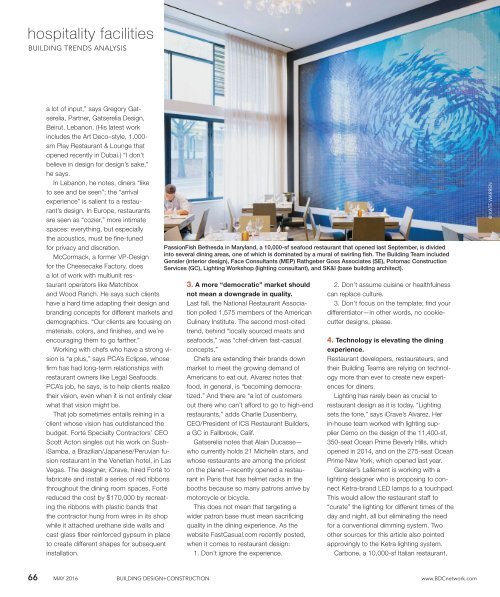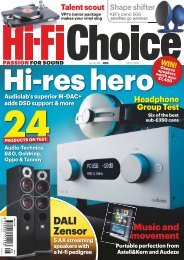Building Design Construction
Create successful ePaper yourself
Turn your PDF publications into a flip-book with our unique Google optimized e-Paper software.
hospitality facilities<br />
BUILDING TRENDS ANALYSIS<br />
a lot of input,” says Gregory Gatserelia,<br />
Partner, Gatserelia <strong>Design</strong>,<br />
Beirut, Lebanon. (His latest work<br />
includes the Art Deco–style, 1,000-<br />
sm Play Restaurant & Lounge that<br />
opened recently in Dubai.) “I don’t<br />
believe in design for design’s sake,”<br />
he says.<br />
In Lebanon, he notes, diners “like<br />
to see and be seen”; the “arrival<br />
experience” is salient to a restaurant’s<br />
design. In Europe, restaurants<br />
are seen as “cozier,” more intimate<br />
spaces: everything, but especially<br />
the acoustics, must be fi ne-tuned<br />
for privacy and discretion.<br />
McCormack, a former VP-<strong>Design</strong><br />
for the Cheesecake Factory, does<br />
a lot of work with multiunit restaurant<br />
operators like Matchbox<br />
and Wood Ranch. He says such clients<br />
have a hard time adapting their design and<br />
branding concepts for different markets and<br />
demographics. “Our clients are focusing on<br />
materials, colors, and fi nishes, and we’re<br />
encouraging them to go farther.”<br />
Working with chefs who have a strong vision<br />
is “a plus,” says PCA’s Eclipse, whose<br />
fi rm has had long-term relationships with<br />
restaurant owners like Legal Seafoods.<br />
PCA’s job, he says, is to help clients realize<br />
their vision, even when it is not entirely clear<br />
what that vision might be.<br />
That job sometimes entails reining in a<br />
client whose vision has outdistanced the<br />
budget. Forté Specialty Contractors’ CEO<br />
Scott Acton singles out his work on SushiSamba,<br />
a Brazilian/Japanese/Peruvian fusion<br />
restaurant in the Venetian hotel, in Las<br />
Vegas. The designer, iCrave, hired Forté to<br />
fabricate and install a series of red ribbons<br />
throughout the dining room spaces. Forté<br />
reduced the cost by $170,000 by recreating<br />
the ribbons with plastic bands that<br />
the contractor hung from wires in its shop<br />
while it attached urethane side walls and<br />
cast glass fi ber reinforced gypsum in place<br />
to create different shapes for subsequent<br />
installation.<br />
PassionFish Bethesda in Maryland, a 10,000-sf seafood restaurant that opened last September, is divided<br />
into several dining areas, one of which is dominated by a mural of swirling fish. The <strong>Building</strong> Team included<br />
Gensler (interior design), Face Consultants (MEP) Rathgeber Goss Associates (SE), Potomac <strong>Construction</strong><br />
Services (GC), Lighting Workshop (lighting consultant), and SK&I (base building architect).<br />
3. A more “democratic” market should<br />
not mean a downgrade in quality.<br />
Last fall, the National Restaurant Association<br />
polled 1,575 members of the American<br />
Culinary Institute. The second most-cited<br />
trend, behind “locally sourced meats and<br />
seafoods,” was “chef-driven fast-casual<br />
concepts.”<br />
Chefs are extending their brands down<br />
market to meet the growing demand of<br />
Americans to eat out. Alvarez notes that<br />
food, in general, is “becoming democratized.”<br />
And there are “a lot of customers<br />
out there who can’t afford to go to high-end<br />
restaurants,” adds Charlie Dusenberry,<br />
CEO/President of ICS Restaurant Builders,<br />
a GC in Fallbrook, Calif.<br />
Gatserelia notes that Alain Ducasse—<br />
who currently holds 21 Michelin stars, and<br />
whose restaurants are among the priciest<br />
on the planet—recently opened a restaurant<br />
in Paris that has helmet racks in the<br />
booths because so many patrons arrive by<br />
motorcycle or bicycle.<br />
This does not mean that targeting a<br />
wider patron base must mean sacrifi cing<br />
quality in the dining experience. As the<br />
website FastCasual.com recently posted,<br />
when it comes to restaurant design:<br />
1. Don’t ignore the experience.<br />
2. Don’t assume cuisine or healthfulness<br />
can replace culture.<br />
3. Don’t focus on the template; fi nd your<br />
differentiator—in other words, no cookiecutter<br />
designs, please.<br />
4. Technology is elevating the dining<br />
experience.<br />
Restaurant developers, restaurateurs, and<br />
their <strong>Building</strong> Teams are relying on technology<br />
more than ever to create new experiences<br />
for diners.<br />
Lighting has rarely been as crucial to<br />
restaurant design as it is today. “Lighting<br />
sets the tone,” says iCrave’s Alvarez. Her<br />
in-house team worked with lighting supplier<br />
Cerno on the design of the 11,400-sf,<br />
350-seat Ocean Prime Beverly Hills, which<br />
opened in 2014, and on the 275-seat Ocean<br />
Prime New York, which opened last year.<br />
Gensler’s Lallement is working with a<br />
lighting designer who is proposing to connect<br />
Ketra-brand LED lamps to a touchpad.<br />
This would allow the restaurant staff to<br />
“curate” the lighting for different times of the<br />
day and night, all but eliminating the need<br />
for a conventional dimming system. Two<br />
other sources for this article also pointed<br />
approvingly to the Ketra lighting system.<br />
Carbone, a 10,000-sf Italian restaurant,<br />
@ KATE WARREN<br />
66 MAY 2016 BUILDING DESIGN+CONSTRUCTION www.BDCnetwork.com






